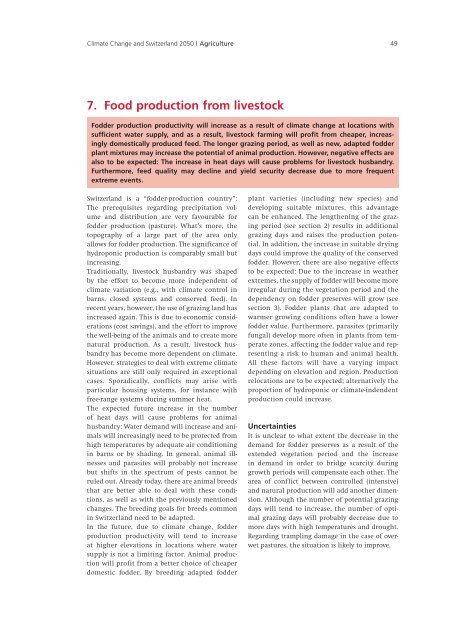Climate Change and Switzerland 2050 - OcCC - SCNAT
Climate Change and Switzerland 2050 - OcCC - SCNAT
Climate Change and Switzerland 2050 - OcCC - SCNAT
You also want an ePaper? Increase the reach of your titles
YUMPU automatically turns print PDFs into web optimized ePapers that Google loves.
<strong>Climate</strong> <strong>Change</strong> <strong>and</strong> Switzerl<strong>and</strong> <strong>2050</strong> | Agriculture 49<br />
7. Food production from livestock<br />
Fodder production productivity will increase as a result of climate change at locations with<br />
sufficient water supply, <strong>and</strong> as a result, livestock farming will profit from cheaper, increasingly<br />
domestically produced feed. The longer grazing period, as well as new, adapted fodder<br />
plant mixtures may increase the potential of animal production. However, negative effects are<br />
also to be expected: The increase in heat days will cause problems for livestock husb<strong>and</strong>ry.<br />
Furthermore, feed quality may decline <strong>and</strong> yield security decrease due to more frequent<br />
extreme events.<br />
Switzerl<strong>and</strong> is a “fodder-production country”:<br />
The prerequisites regarding precipitation volume<br />
<strong>and</strong> distribution are very favourable for<br />
fodder production (pasture). What’s more, the<br />
topography of a large part of the area only<br />
allows for fodder production. The significance of<br />
hydroponic production is comparably small but<br />
increasing.<br />
Traditionally, livestock husb<strong>and</strong>ry was shaped<br />
by the effort to become more independent of<br />
climate variation (e.g., with climate control in<br />
barns, closed systems <strong>and</strong> conserved feed). In<br />
recent years, however, the use of grazing l<strong>and</strong> has<br />
increased again. This is due to economic considerations<br />
(cost savings), <strong>and</strong> the effort to improve<br />
the well-being of the animals <strong>and</strong> to create more<br />
natural production. As a result, livestock husb<strong>and</strong>ry<br />
has become more dependent on climate.<br />
However, strategies to deal with extreme climate<br />
situations are still only required in exceptional<br />
cases. Sporadically, conflicts may arise with<br />
particular housing systems, for instance with<br />
free-range systems during summer heat.<br />
The expected future increase in the number<br />
of heat days will cause problems for animal<br />
husb<strong>and</strong>ry: Water dem<strong>and</strong> will increase <strong>and</strong> animals<br />
will increasingly need to be protected from<br />
high temperatures by adequate air conditioning<br />
in barns or by shading. In general, animal illnesses<br />
<strong>and</strong> parasites will probably not increase<br />
but shifts in the spectrum of pests cannot be<br />
ruled out. Already today, there are animal breeds<br />
that are better able to deal with these conditions,<br />
as well as with the previously mentioned<br />
changes. The breeding goals for breeds common<br />
in Switzerl<strong>and</strong> need to be adapted.<br />
In the future, due to climate change, fodder<br />
production productivity will tend to increase<br />
at higher elevations in locations where water<br />
supply is not a limiting factor. Animal production<br />
will profit from a better choice of cheaper<br />
domestic fodder. By breeding adapted fodder<br />
plant varieties (including new species) <strong>and</strong><br />
developing suitable mixtures, this advantage<br />
can be enhanced. The lengthening of the grazing<br />
period (see section 2) results in additional<br />
grazing days <strong>and</strong> raises the production potential.<br />
In addition, the increase in suitable drying<br />
days could improve the quality of the conserved<br />
fodder. However, there are also negative effects<br />
to be expected: Due to the increase in weather<br />
extremes, the supply of fodder will become more<br />
irregular during the vegetation period <strong>and</strong> the<br />
dependency on fodder preserves will grow (see<br />
section 3). Fodder plants that are adapted to<br />
warmer growing conditions often have a lower<br />
fodder value. Furthermore, parasites (primarily<br />
fungal) develop more often in plants from temperate<br />
zones, affecting the fodder value <strong>and</strong> representing<br />
a risk to human <strong>and</strong> animal health.<br />
All these factors will have a varying impact<br />
depending on elevation <strong>and</strong> region. Production<br />
relocations are to be expected; alternatively the<br />
proportion of hydroponic or climate-indendent<br />
production could increase.<br />
Uncertainties<br />
It is unclear to what extent the decrease in the<br />
dem<strong>and</strong> for fodder preserves as a result of the<br />
extended vegetation period <strong>and</strong> the increase<br />
in dem<strong>and</strong> in order to bridge scarcity during<br />
growth periods will compensate each other. The<br />
area of conflict between controlled (intensive)<br />
<strong>and</strong> natural production will add another dimension.<br />
Although the number of potential grazing<br />
days will tend to increase, the number of optimal<br />
grazing days will probably decrease due to<br />
more days with high temperatures <strong>and</strong> drought.<br />
Regarding trampling damage in the case of overwet<br />
pastures, the situation is likely to improve.

















